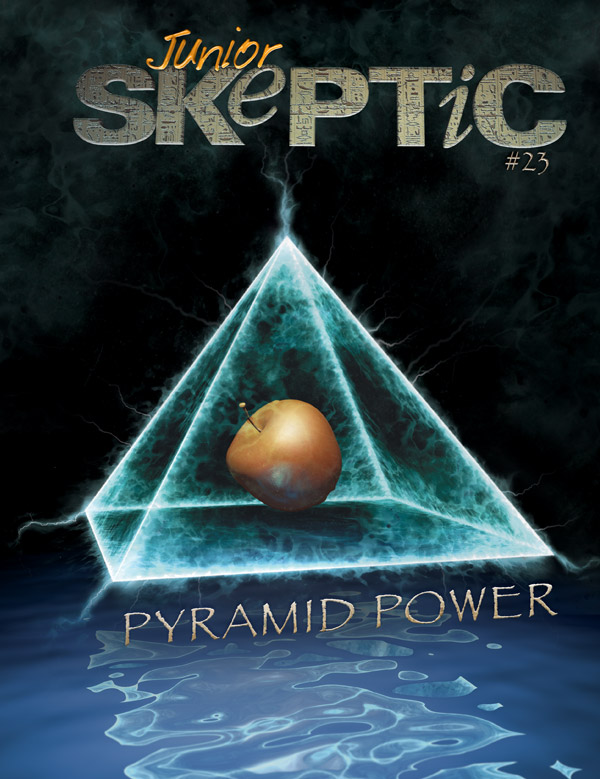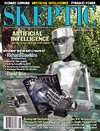Prior to Junior Skeptic, no English-language source seems to have ever taken a hard critical look at the legendary version of Antoine Bovis’s “discovery” of pyramid power.
The best source on this topic was a Danish-language book by skeptic Jens Laigaard. With the help of translation software (and a good dictionary), I was able to hammer out a rough translation of the relevant section of Chapter Eight. Luckily, Laigaard’s English is impeccable, and he was generously willing to correct and refine the translation.
We present that passage here, with thanks to Jens Laigaard and our other colleagues at the Danish skeptics.
READ the entire book online in the original Danish (external link) >
Probing the Bovis Legend
Chapter Eight: Mummification

a Danish-language skeptical book
The first pyramid power experiments concerned the mummification of organic material. Countless books and articles have described how Antoine Bovis, during a visit to the Great Pyramid of Khufu, began to suspect that pyramidal shapes were capable of causing quick dehydration, and how later experiments corroborated his assumption.
Bovis in the king’s chamber… Here it began; here the theory of pyramid power was born. In light of the major importance pyramid power authors attach to Bovis’s pyramid discovery, it’s strange that no one seems to know when it happened. Toth and Nielsen write that it was “sometime during the 1900s.”1 Ostrander and Schroeder pronounce, with equal exactness, that it occurred “some years ago.”2 Other authors propose the late 1920s, or the early 30s.
All things considered, we have only Bovis’s word that he ever visited the pyramids.3 However, there’s a detail in his story that permits us to evaluate its credibility. One can easily imagine the scene as it has been described over and over again. Bovis steps idly into the king’s chamber, with its dark brown, burnished walls. He is a little dazed from the heat, but his senses are wide open. On the right of the oblong room stands the granite sarcophagus, one corner broken to pieces. There’s also a garbage can in the room, with the corpses of some cats and other small animals that have wandered into the building and not been able to find their way out again. Bovis notices that there is no stench of rot coming from the dead animals. Curious, he approaches the garbage can and picks up one of the little carcasses, which is light, dry, and mummified. This discovery leads Bovis to speculate….
It also ought to make us stop and think. The king’s chamber is the most remote and least accessible room in the pyramid. Isn’t it strange that the groundskeepers would carry dead animals up here instead of just throwing them out of the building right away? Furthermore, the king’s chamber is the most famous room in the world’s most famous ancient monument. Isn’t it strange that exactly this room would be obstructed with a garbage can filled with dead animals?
Indeed, it’s beyond strange: in so many words, it’s an outright lie.
According to a source we may consider very well informed (namely, the former Director of the Egyptian National Museum), there have never been any garbage cans placed in the king’s chamber. So whether Bovis was ever at the pyramid or not, we know that the narrative surrounding his discovery of those mummified animals was freely invented. Pyramid power’s founding tale (for which a date or year has never been provided), is then abruptly and completely ruled out as history.
Seeking the birthplace of the theory, we turn our eyes to the French Riviera, to the town of Nice. Here Bovis, apparently in an inspired moment, links “radiesthesic” theory [dowsing, often with pendulums] to the notion that there’s something special about the proportions of the Great Pyramid. It was in Nice that Bovis is alleged to have demonstrated that a 30-inch tall wooden model of the Great Pyramid was capable of mummifying a dead cat. We have, of course, only Bovis’s own claim that this and subsequent experiments gave successful results; however, today we are no longer obliged to exclusively rely on Monsieur Bovis’s dubious assertion. Mummification became a hugely popular amateur experiment when the cardboard pyramid fad took off. Thousands of people have tried leaving various foodstuffs inside a pyramid, and they’ve advanced numerous assertions that pyramid power can preserve fish, meat, eggs, vegetables, fruit and milk. Cut flowers treated by the energy, will by all accounts keep their color and fragrance. Moreover, coffee, wine, liquor and tobacco are said to give off a more appetizing aroma after a turn in a pyramid.
READ this chapter in the original Danish (external link) >
Endnotes
-
Toth, Max, and Greg Nielson. Pyramid Power. (New York: Warner Destiny, 1976). 158.
-
Ostrander, Sheila, and Lynn Schroeder. Psychic Discoveries Behind the Iron Curtain. (New Jersey: Prentice-Hall, 1970). 340.
-
Laigaard did not have access to Bovis’s lost writings on the topic, and thus did not know that Bovis was apparently not the source of the legend in which he is featured. According to Bovis, he formed his pyramid ideas through armchair reasoning and occult experiments in France, “Being unable to go [to Egypt] to experiment and verify the radiations of the Cheops Pyramid” in person.
Download Exposé de M. A. Bovis au Congrès International de Radiotellerie à Nice by Antoine Bovis in original French (3.6 MB PDF). Or, read the relevant section in English at Skeptic.com.










